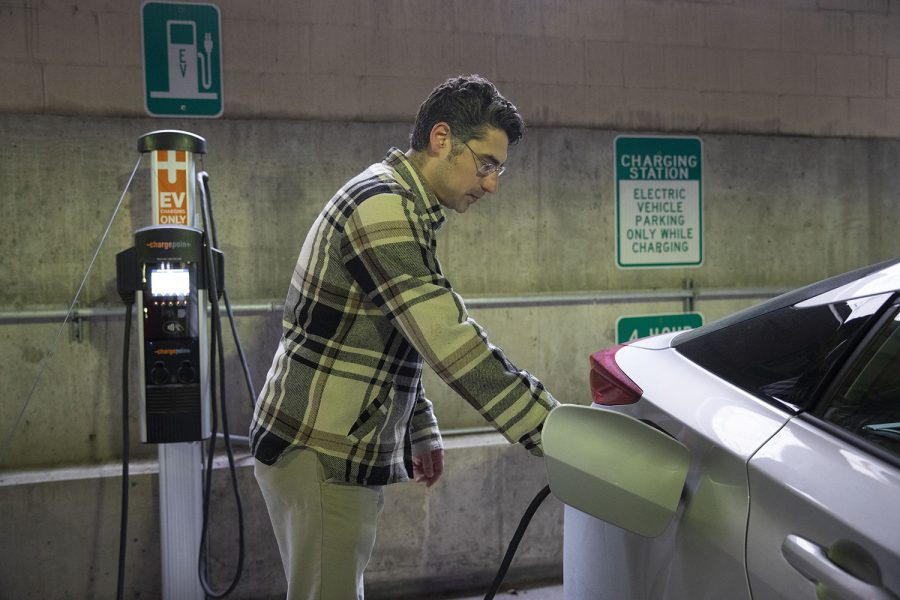Electric vehicle ownership increasing in Johnson County, Iowa DOT measures
Johnson County had 883 registered electric vehicles as of December 31, 2021, putting it second in the state only behind Polk County. Iowa City rolled out a rebate program for apartment and condominium associations that build charging stations on their properties.
Iowa City Climate Action and Outreach division member Daniel Bissell unplugs his electric car at the Tower Place parking garage in Iowa City on Monday, April 13, 2022.
April 17, 2022
Demand for electric vehicles in Johnson County is creeping upward.
As of December 31, 2021, Johnson County drivers owned the second-highest number of registered electric vehicles in Iowa, with 883 compared to Polk County’s 1,889, according to an Iowa Department of Transportation report.
Johnson County’s population is one-fifth the size of Polk’s, meaning the county has the most electric vehicles in the state per capita.
In March 2020, Johnson County had only 549 registered electric vehicles, according to the Iowa DOT.
Sarah Gardner, Iowa City climate action coordinator, said the increasing demand for electric vehicles in Johnson County and all over Iowa is seen not only in the number of vehicles purchased, but also in the data from the city’s electric vehicle charging stations.
From 2017 to 2021, the 12 electric vehicle charging ports in Iowa City in the parking garages combined to save over 136,000 pounds of greenhouse gas, according to a City of Iowa City Tweet.
In 2019, the number of unique users in a given month peaked at just over 100. Since mid-2021, the number of unique users in a month has not dropped below 120 and reached a new high in March at over 160.
Daniel Bissell, Iowa City climate action analyst, said the increase in electric vehicle drivers speaks to the availability of different electric vehicle models and the market penetration that is starting to happen in Johnson County.
“The city is monitoring the usage and planning on expanding as the usage and as the demand grows,” Bissell said.
Charging at the stations is currently free, but that could change if a new Iowa law requiring the commercial dispensing of electric fuel charging to be taxed, starting in 2023, applies to the city’s charging stations, Gardner said.
Bissell said while Iowa City has made more charging available around the city, 80 percent of electric vehicle charging occurs at home.
Iowa City Climate Action and Outreach rolled out a rebate program about a month ago for apartments and condos to make electric vehicle charging more available to renters and people without garages.
The program will cover half of the installation costs for apartment and condominium associations that choose to install electric vehicle charging stations.
“More than 50 percent of the folks who live in Iowa City rent,” Gardner said. “So, trying to get those resources to rental units, I think, is a key initiative of ours.”
Gardner said the Iowa City Climate Action and Outreach division is combatting the multiple misconceptions surrounding electric vehicles including that they are:
- Only for the wealthy
- Unreliable and slow
- Unable to last very long on a single charge
Gardner said there is a variety of affordable vehicles with the ability to travel 250-350 miles on a single charge, and because there are fewer moving parts in an electric vehicle’s engine, the cars can accelerate with greater ease than those with combustion engines.
Bissell said a common misconception he sees is people thinking Tesla is the only maker of electric vehicles.
In reality, companies like Toyota, Chevrolet, or Nissan make a variety of electric vehicles. Bissell said availability and awareness of these cars will play a huge factor in the number of people buying electric vehicles.
“More and more manufacturers are coming out with vehicles all the time and in all segments of the market: sedans, minivans, trucks,” he said. “Having that availability in all market segments and from a variety of manufacturers will, I think, get more people to switch.”















